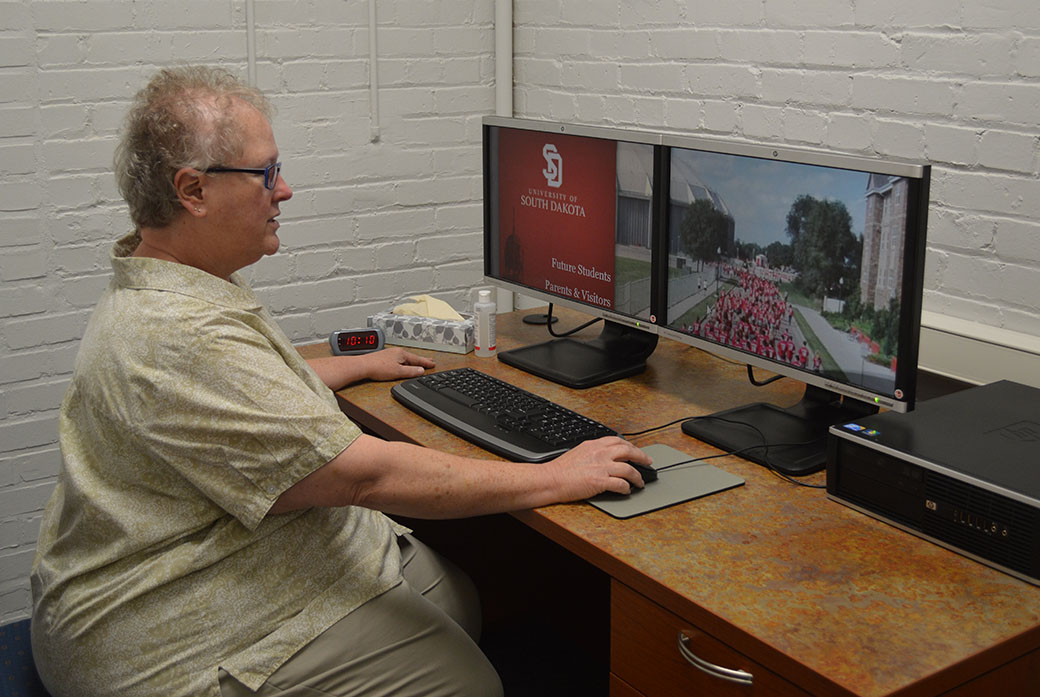
Disability Services sees increase in use among students
When Beau Brady suffered a traumatic brain injury while obtaining his undergraduate degree around 2010, his rehab therapists in Omaha, Neb., made a point to drive him to Disability Services at the University of South Dakota.
Brady now takes advantage of the services, utilizing note-takers in his classes and the chance to take tests at the Service Center for an extended time period.
“They don’t study for me — I still do all the work,” said Brady, who is obtaining his graduate degree in interdisciplinary studies. “But I feel independent using the accommodations.”
That independence is the exact goal Disability Services and social security attorneys strives for, said Ernetta Fox, director for Disability Services.
“There is no discrimination,” she said. “The goal is to give the students with all types of disabilities full and equal access to the resources they need, and if they need assistance with that we help them.”
Those disabilities are wide-ranging and throughout the last three years, Fox said there has been an increase in services for those with chronic impairments of the immune system, such as cancer. Disability Services also provides resources for temporary disabilities such as knee crutches and wheelchairs when students have visiting families coming to campus. Sign language interpreters are also available.
“There are more cases of disabilities across the nation, too, and that’s being reflected here,” she said.
But the law draws the line between personal services and vocational rehab services. Fox and her staff do not tutor students who come to them, but they can point them in the right direction to get those services.
The majority of students who use Disability Services are in the age group of 17-25 years old. One hundred and twenty-five are female this semester, and 82 are male, for a total of 214 people at least talking with someone at Disability Services. There are 126 active accommodations — students who took advantage of the services available to them.
In the fall of 2012 there were 126 active accommodations, with 131 in the spring of 2013. One hundred and thirty-nine students utilized the services in fall 2013.
The largest category of disability the USD program treats is learning disabilities, such as dyscalculia — problems with math — and dysgraphia — having a harder time with writing, with 75 students. ADD and ADHD have the second highest number in disability type with 70 students.
Ninety-three of the 126 students take their exams separate from class for minimal distractions, while 68 people use extended time for exams.
Junior Leah Saiz also uses the services for test anxiety and memory retention. She uses a special pen in class to record her lectures. She also takes tests at the Services Center.
Saiz opted out of every service her first semester of college except for those she could use in math, but said that caught up with her second semester.
“I decided to go through Native Student Services, and they pointed me to Disability Services,” she said. “I was embarrassed because of the stigma of disabilities, but they were very welcoming. Now I feel more connected with my professors and I’ve seen a change in my confidence.
buy augmentin online https://alvitacare.com/wp-content/languages/new/where/augmentin.html no prescription
”
Fox said sometimes students coming from high school think of disability services like the resource room, which can cause apprehension to use the services.
“No one wants to sit in a resource room all day,” she said. “Here, we’re focused on the individual and we work on their terms. We make sure they are aware of all available services.”
USD also provides distant-education services for non-traditional students in Sioux Falls, Pierre, Rapid City, Seattle, Minneapolis, Panama and some cities on the east coast.
First-year Brandi Vissers also uses the services because she is visually impaired. The Services Center has a designated room for her to take her tests, with equipment such as a double monitor and technology called Zoom Text, which magnifies the text as much as needed.
“I wouldn’t be able to be in school if it wasn’t for the services,” said Vissers, an accounting major. “When we have to do a test with a scan tron, I can’t even differentiate the bubbles, so I go in to the center and circle the right answer and they transfer it for me.”
Vissers said her professors informed her of Disability Services during the first week of classes, making it easily accessible to anyone who needs it.
“They’re really easy to get a hold of, they always call you back if they miss your call and I’ve never had any frustrations with them,” she said.
For Brady, the services have particularly helped with stress.
“They’ve done a lot for me,” he said. “School is hard enough without a disability, and I struggle to write every little thing down in class. They don’t study for me, but now I’m very comfortable being able to use the services.”
(Ernetta Fox, the director of disability services at the university of South Dakota, works on a computer that has an extra large screen for visually impaired students. Amber Bock / The Volante)


